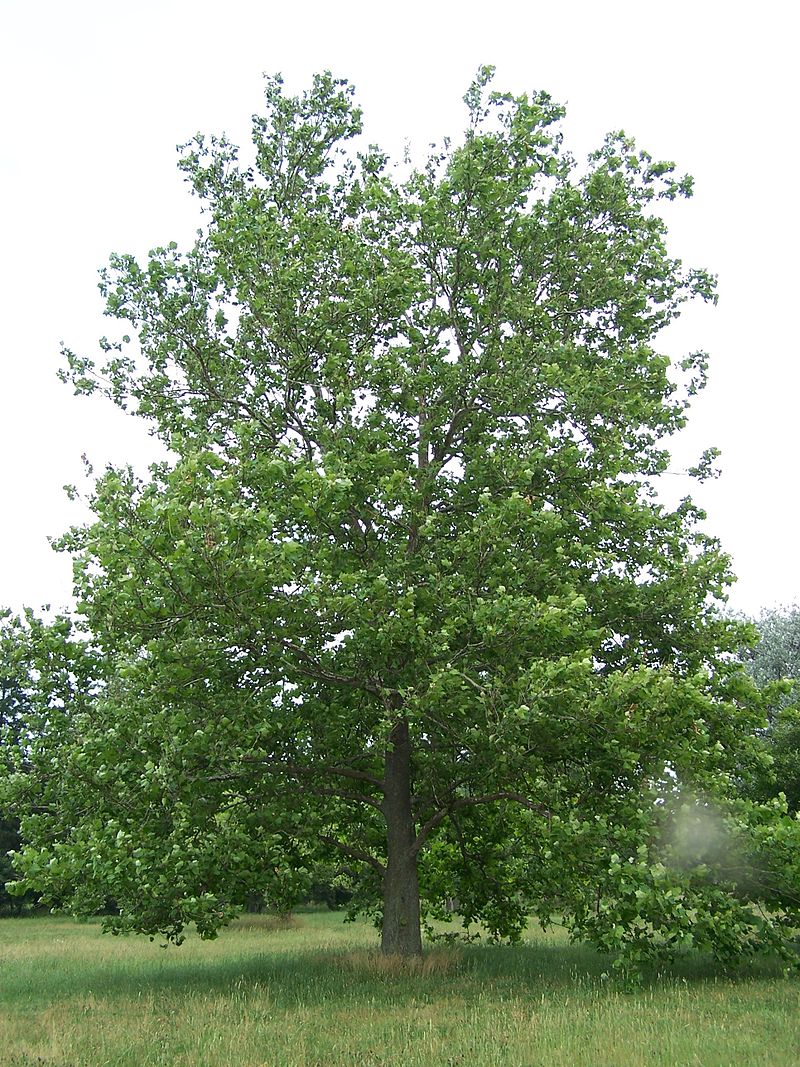American Sycamore
 Platanus occidentalis, or Sycamore, is native in Eastern United States from eastern one-third of Kansas to Maine and Florida. It usually grows along rivers. Sycamore is one of the largest trees in the state reaching a height of about 80 feet with immense spreading branches. Its growth rate is rapid when young if it has sufficient moisture. This species needs full sun light.
Platanus occidentalis, or Sycamore, is native in Eastern United States from eastern one-third of Kansas to Maine and Florida. It usually grows along rivers. Sycamore is one of the largest trees in the state reaching a height of about 80 feet with immense spreading branches. Its growth rate is rapid when young if it has sufficient moisture. This species needs full sun light.
Leaves, Stems and Fruit
The leaves are simple and alternately arranged on the twig with 3 or 5 pointed lobes and a few coarse teeth. Base is lobed or straight or with a small triangular portion of the blade extended along the petiole. Yellow-green to medium green above, paler green beneath with pale hairs along the veins. May reach 6-10 inches long and 4-6 wide. It has a leaf-like stipule on the stem above the leaf. Twigs are green to slightly brown or gray-brown, coarse, rigid, enlarged at the nodes. Buds are cone-shaped developing inside the base of the petiole with only one bud scale. Bark is dark brown when young but becomes white to greenish-white and showy with age. Flowers are separate on the same tree and not showy. Fruit is golf ball-like and is green when young and brown when mature.
Use
Wildlife Habitat - Sycamores make good den and roost trees
Riparian Buffers - It is often is a good selection for riparian plantings due to its high flood tolerance and extensive root system.
Adaptation and Soil
Sycamore has adapted to the eastern half of Kansas and is moderately tolerant to a broad range of soils with adequate soil moisture. This is not a tree for a droughty site.
Spacing
Space at 8 feet in riparian and 30 feet in wildlife plantings.
Culture
One-year-old, bare-root seedlings (14 to 18 inches tall) are used in conservation plantings. During the establishment period, supplemental watering and control of competing vegetation will aid survival and early growth.
Pests
Anthracnose and lacebugs are common problems.
Soil Information
| Average Height in 20 Yrs: | |
| -Eastern | 32-36 ft. |
| -Central | 30-34 ft |
| -Western | Not Suitable |
| Growth Rate: | Fast |
| Native Species: | Native to Kansas |
| Windbreak Value: | Low |
| Wildlife Value: | Medium |
| Lumber Products: | Yes |
| Fuelwood Products: | Yes |
| Drought Tolerance: | Medium |
| Texture: | 2,3 |
| Soil Saturation: | High Tolerance |
| Salinity Tolerance: | No Tolerance |
| pH Range: | 4.9-6.5 |